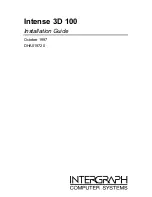
DNA-CAR-550 Carrier Board
Chapter 1
5
Introduction
Edit: TBD
Checked: TBD
Date:210
Vers:
Draft
Scheidt & Bachmann
550_Chap1.fm
© Copyright February 15, 2010 Scheidt &
Bachmann USA
www.ueidaq.com
Vers:
1.0
printed February 2010
Fax: 781-821-2891
Electronic Industries, Inc.
-821-2890
Tel: 508-921-4600
www.ueidaq.com
Vers:
1.2
Date: February 2010
550_Chap1.fm
© Copyright 2010 all rights reserved
United Electronic Industries, Inc.
1.4
Specifi-
cations
The following table lists the technical specifications of the CAR-550 board.
1.5
What is PCI
Express
PCI Express is an extension of the PCI bus standard that greatly increases the
bandwidth, range of platforms, and form factors of devices on which it can be
used. It is backward-compatible with old PCI applications but also capable of
handling a much wider variety of current and future systems such as desktop,
mobile, server, communications, workstations, and embedded devices.
1.6
SIM Card
A subscriber identity module (SIM) on a removable SIM card securely stores the
service-subscriber key (IMSI) used to identify a subscriber on mobile telephony
devices such as computers and mobile phones. The SIM card allows users to
change phones (and providers) by simply removing the SIM card from one
mobile phone and inserting it into another mobile phone or broadband telephony
device.
A SIM card contains its unique serial number, international unique number of the
mobile user (IMSI), security authentication and ciphering information, temporary
information related to the local network (also temporary local id that has been
issued to the user), a list of the services the user has access to and two
passwords (PIN for usual use and PUK for unlocking).
SIM cards are available in two standard sizes. The first is the size of a credit card
(85.60 mm × 53.98 mm x 0.76 mm). The newer, more popular miniature version
has a width of 25 mm, a length of 15 mm, and a thickness of 0.76 mm. However,
most SIM cards are still supplied as a full-sized card with the smaller card held
in place by a few plastic links; it can easily be broken off to be used in a phone
that uses the smaller SIM
1.7
USB 2.0
The USB 1.0 specification was introduced in 1996.for the purpose of making it
easy to connect external devices to PCs by replacing the multitude of
connectors at the back of PCs, addressing the usability problems of existing
interfaces, and to simplify software configuration of all devices connected to the
bus, as well as to permit greater bandwidth for external devices. The original
USB 1.0 specification had a data transfer rate of 12 Mbit/s.
Technical Specifications:
Carrier card type
PCI Express Mini Card that utilize the
USB Interface
SIM/UIM card interface
Accepts standard cards from Cell carrier.
May be installed from outside of chassis
Communications interface
USB 2.0
Indicator LEDs
4 provided (1 indicates power is on, 3
are controlled by PCI Express Mini Card)
RF connectors
2
RF connector type
Standard SMA connector
Optional RPSMA connectors also
available
Power dissipation
< 1 W, not including PCI Express Card
Operating Temp. Range
Tested -40 to +85 °C
Operating Humidity
95%, non-condensing
Vibration
IEC 60068-2-6
IEC 60068-2-64
5 g, 10-500 Hz, sinusoidal
5 g (rms), 10-500 Hz, broad-band random
Shock
IEC 60068-2-27
50 g, 3 ms half sine, 18 shocks @ 6 orientations
30 g, 11 ms half sine, 18 shocks @ 6 orientations
MTBF
300,000 hours






































